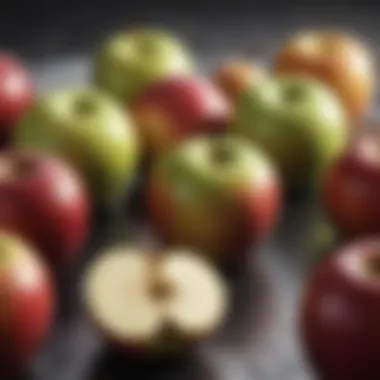Understanding Good Cooking Apples: Varieties & Tips


Intro
Cooking apples represent a unique category of apples prized for their culinary properties rather than their taste when eaten raw. Understanding the varieties that fall into this category is essential for anyone looking to enhance their cooking skills. This guide will explore the characteristics of good cooking apples, including their texture, acidity, and flavor profiles, which are crucial for various culinary applications.
Good cooking apples hold their shape when cooked, making them perfect for pies, tarts, and other desserts. Moreover, they possess just the right level of sweetness and tartness to complement different dishes. Choosing the right variety for the right recipe can elevate a meal from ordinary to extraordinary.
This article aims to inform readers about different cooking apple varieties, their best uses, and practical tips for selection. Armed with this knowledge, home cooks can make informed decisions in the produce aisle, ensuring their dishes not only taste great but also showcase the best cooking apples available.
Intro to Cooking Apples
Cooking apples play a crucial role in the culinary world, serving as a fundamental ingredient in a multitude of recipes, from sweet pies to savory dishes. Their distinct characteristics make them essential for individuals looking to add depth and flavor to their meals. This section delves into what defines a good cooking apple, the importance of these apples in cooking, and how they enhance our culinary practices.
Defining a Good Cooking Apple
A good cooking apple is defined by several essential qualities. These apples typically exhibit a firm texture, which allows them to retain shape during cooking. Cooking apples are often tart or slightly sweet, striking a balance that makes them suitable for both baked and savory dishes. Unlike dessert apples, which are meant to be eaten raw, cooking apples are more acidic. This acidity not only adds bright flavors to dishes but also helps to counterbalance the sweetness of other ingredients.
When selecting a cooking apple, consider both its taste and texture. Varieties such as Granny Smith or Rome Beauty are popular choices due to their unique flavor profiles and excellent cooking abilities. Moreover, good cooking apples should have an unblemished skin, free from bruises or soft spots, indicating freshness and quality.
Importance in Culinary Practices
Cooking apples are of significant importance in various culinary practices due to their versatility. They can be used in numerous applications, ranging from baking, such as producing the classic apple pie, to savory dishes where apples complement meats or enhance vegetable medleys.
The culinary significance of cooking apples extends further with their ability to maintain flavor integrity when cooked. They not only absorb surrounding flavors but also impart their unique taste to the dish. Utilizing the right cooking apple can transform a bland meal into a delightful experience.
Cooking apples also serve practical purposes in recipes. For instance, their higher acidity assists in the preservation of color and improves texture when used in sauces or purees. By understanding the qualities and uses of cooking apples, cooks can elevate their dishes, making informed choices that align with their culinary goals.
"The true essence of good cooking apples lies in their ability to improve the harmonious balance of flavors, making every dish a worthwhile endeavor."
In summary, cooking apples are not merely ingredients; they are a vital aspect of culinary creativity, impacting flavor, texture, and overall presentation in dishes. Recognizing the distinctive features of cooking apples is essential for anyone looking to deepen their culinary skills.
Characteristics of Cooking Apples
To understand cooking apples thoroughly, one must delve into their specific characteristics that set them apart from other apple varieties. These features are crucial because they dictate not only the apple's utility in the kitchen but also the satisfaction derived from various dishes. Cooking apples are not simply chosen for their taste; the key attributes define how they can be applied in recipes, enhancing the overall culinary experience.
Optimal Flavor Profiles
The flavor profile of cooking apples plays a significant role in their culinary applications. A good cooking apple usually presents a complex taste. Granny Smith apples, for example, are known for their sharp tartness, making them essential for recipes that require a bright flavor. This sourness works well, especially in sweet desserts, as it provides a counterbalance that elevates the dish.
Other varieties such as Braeburn showcase a blend of sweet and tart notes. This balance allows cooks to utilize them in both sweet pies and savory dishes. The choice of apple variety can greatly influence the final flavor of a dish, marking the importance of understanding fruit profiles when selecting apples for cooking.
Ideal Texture for Cooking
The texture of cooking apples is equally essential. It goes beyond merely being soft or firm; the right texture determines how well the apple holds up during cooking processes. Typically, good cooking apples have a firmer flesh that can withstand heat without turning to mush.
For instance, Rome Beauty apples maintain their shape admirably during baking, making them ideal for tarts. Conversely, Golden Delicious apples have a tendency to break down more quickly. Understanding these textural differences can guide cooks in recipe selection and the expected outcomes after cooking.
Acidity and Sweetness Balance
The balance between acidity and sweetness is a fundamental aspect of cooking apples. A well-rounded apple possesses an appropriate level of acidity that complements its sweetness. This balance is pivotal for enhancing the flavors in dishes, especially in desserts like crumbles or pies.
Apples like Braeburn strike a remarkable balance, pulling both elements together nicely. In contrast, excessively sweet apples may not contribute the desired complexity needed in savory dishes, leading to a less fulfilling culinary experience. Consequently, recognizing this balance can influence both ingredient choice and recipe success in cooking.
Popular Cooking Apple Varieties
Cooking apples come in various types, each distinct in flavor and texture. Understanding these varieties is crucial for maximizing their culinary potential. Each variety has unique characteristics, making them suited for specific applications.


Knowing which cooking apple to use can greatly enhance the taste and texture of your dishes. It is important to see not just the flavor but also how well each variety holds up during cooking.
Granny Smith
Granny Smith apples are renowned for their tart flavor. Their sourness is a significant aspect in culinary applications, contributing brightness to dishes. This variety balances sweetness with a delightful tang, making it an excellent choice for recipes that require a contrasting taste. The sourness also complements rich flavors, making them a favorite in sweet and savory dishes.
Sourness and Its Culinary Role
The distinct sourness of Granny Smith is its most notable feature. This tartness plays a pivotal role in various recipes, allowing it to stand out in pies and crumbles. Its acidity cuts through the richness of ingredients, enhancing overall flavor. This aspect makes it a popular option for both baking and cooking, as it adds depth to flavors and balances sweetness in desserts. The flavor profile appeals widely, especially in recipes that need a sharper taste.
Best Use Cases
Granny Smith apples are versatile in use. Their firmness and tartness make them ideal for traditional dishes like apple pie, where they hold their shape during baking. They can also enhance salads or be used in salsas due to their crisp texture. These apples are popularly chosen for making apple chutneys or in savory dishes like pork or chicken. However, their tartness might not appeal to those seeking a sweeter taste.
Braeburn
Braeburn apples offer a complex flavor profile, combining both sweetness and tartness. This duality makes them suitable for various culinary applications. Their balanced taste elevates many traditional recipes, showcasing their importance in the culinary world.
Complex Flavor Profile
The flavor complexity of Braeburn is distinguished by its blend of sweet and tangy notes. This aspect aids in creating multidimensional flavors in recipes. When used in cooking, Braeburn's complexity can enhance desserts, providing a rich backdrop to sweeter elements. This makes it a beneficial choice for both novice cooks and experienced chefs alike, as it adds sophistication to dishes without any additional effort.
Versatility in Recipes
Braeburn apples shine in their versatility. They can be used effectively in both sweet and savory dishes. Whether in pies, galettes, or roasted alongside meats, they adapt well to various flavors, enhancing intricate recipes. Their adaptability makes them ideal in a range of culinary settings. However, their unique flavor can be delicate, requiring careful pairing to ensure it doesn't get overshadowed.
Golden Delicious
Golden Delicious apples are famous for their sweetness and soft texture. Their mild taste allows them to blend seamlessly into many dishes, making them an excellent option for sauces and purees.
Sweetness and Softness
The hallmark of Golden Delicious apples is their inherent sweetness. This quality makes them a popular choice, as their sweetness allows them to be used without additional sugar in many recipes. The soft texture also makes them easy to cook down and integrate into various dishes, enhancing their practical appeal in culinary practices. However, their soft flesh means they do not retain shape as well during baking, which can be a drawback in certain recipes.
Best For Sauces and Purees
Golden Delicious apples excel in making sauces and purees due to their sweet flavor and soft texture. They break down easily when cooked, blending smoothly for creamy results. This can enhance dishes like applesauce or apple butter, where a silky texture is desired. Their natural sweetness negates the need for extra sugar, streamlining preparation. However, they may not be suitable for dishes where a firmer apple is preferred.
Rome Beauty
Rome Beauty apples are prized for their strong cooking qualities. Their ability to withstand heat makes them a favorite for bakers seeking reliability in their recipes.
Cooking and Baking Qualities
Rome Beauty's most significant quality is its ability to hold shape while cooking. This feature makes it an excellent choice for baking applications like pies and tarts, ensuring that they don't turn to mush. The mild sweetness and sturdy texture pair well with sweet and savory dishes alike. As a result, Rome Beauty apples are cherished for their reliability in creating visually appealing and delicious results.
Texture Retention
The texture retention of Rome Beauty apples is commendable. Unlike softer varieties, they maintain their form even after prolonged cooking. This makes them ideal for dishes where texture matters, like baked goods or roasted arrays. With their excellent ability to hold up, these apples prevent soggy outcomes, contributing to well-balanced culinary creations. Their toughness, however, can lead to less pronounced flavors, requiring careful seasoning to enhance taste.
Selecting the Right Cooking Apple
Choosing the right cooking apple can significantly impact the outcome of a dish. The selection of apples often hinges on various factors, including flavor, texture, and intended use. Understanding these aspects allows cooks to leverage the unique properties of each variety, thereby enhancing their culinary creations. As this article illustrates, the nuances in selecting cooking apples can make the difference between a mediocre dish and an exceptional one. By focusing on quality, seasonal availability, and proper storage, cooks can ensure that they have the best apples for their needs.
Identifying Quality Apples
Appearance and Skin Integrity


The outer appearance of an apple says a great deal about its quality. A good cooking apple should have a firm skin that is free from blemishes, bruises, or soft spots. Smoothness often indicates minimal handling and proper care during transport. Apples with intact skin retain moisture better, contributing to a longer shelf life. The color also matters; for example, Granny Smith apples are ideally bright green, while Red Delicious should be a deep red.
Signs of Freshness
Freshness is critical when selecting cooking apples. A fresh apple feels heavy for its size, suggesting juiciness. Waxy skin is another indicator of freshness. Apples that are almost shiny tend to be fresher. Additionally, the aroma is key; a fragrant apple indicates that it was recently harvested. On the other hand, apples lacking scent could be older and less appealing for cooking purposes.
Seasonal Considerations
Availability of Varieties
Different varieties of cooking apples are available at different times of the year. Knowing when specific types are in season helps to select the best apples. Peak seasons often vary by location; for example, in the United States, harvests of Fuji apples typically peak in late fall. Availability not only affects freshness, but also price and selection, ensuring the best culinary experience.
Optimal Harvest Periods
Understanding the optimal harvest periods for apples is essential as well. Apples picked too early or too late may not develop the desired flavors and textures. Harvest times can vary significantly from region to region, making it important for cooks to be aware of local harvest calendars. Using apples that are at their peak ensures that they are flavorful and suitable for a variety of culinary applications.
Storing Cooking Apples
Best Practices
Proper storage is crucial to maintaining the quality of cooking apples. Apples should be kept in a cool, dry place, ideally in a refrigerator where temperatures stay around 30 to 35 degrees Fahrenheit. They should not be stored near strong-smelling foods since apples can absorb those odors. Furthermore, it is beneficial to keep apples away from potatoes, as the gases emitted from potatoes can lead to a faster breakdown of apple quality.
Longevity Tips
To prolong the life of cooking apples, checking them regularly is considered a good practice. Remove any apples that show signs of spoilage, as one rotten apple can affect the others. Storing apples in perforated bags can enhance air circulation, which is vital for keeping them fresh. If considering long-term storage, freezing apples after washing and slicing them is an option, although this may alter their texture for future cooking.
"Selecting the right cooking apple is as pivotal as the recipe itself. The choice affects flavor, texture, and ultimately, enjoyment of the dish."
By understanding how to select quality apples based on appearance, freshness, and seasonal availability, one can enhance the cooking experience. Proper storage techniques further extend the enjoyment and usability of these versatile fruits.
Culinary Uses of Cooking Apples
Cooking apples support a wide variety of dishes, enhancing flavors and textures. They are not just for desserts but also feature prominently in savory dishes. Apples can provide balance in many recipes, offering a sweet and tart contrast that elevates the overall taste. Understanding their culinary uses is crucial for maximizing their potential in the kitchen.
Baking Applications
Classic Apple Pies
Classic apple pies hold a special place in baking. The combination of cooking apples such as Granny Smith or Rome Beauty provides the right level of tartness and texture. These apples hold their shape during cooking, creating a well-structured pie. The key characteristic of classic apple pie is its comforting familiarity. It enhances gatherings and celebrates seasonal produce. One unique feature of a classic apple pie is its flaky crust that complements the soft filling. This type of dish is often seen as the epitome of home cooking, but it can also be a source of challenge for novice bakers.
Crumbles and Tarts
Crumbles and tarts utilize the natural sweetness and acidity of cooking apples effectively. When prepared correctly, crumbles can be a quick dessert option, while tarts present a more refined choice. The key characteristic of crumbles is their crunchy topping, which contrasts nicely with the apple filling. This makes crumbles a popular option for many cooks. One unique feature of crumbles is their ease of preparation and flexibility in ingredients. However, if not baked properly, the topping may become too soggy, detracting from the overall texture.
Savory Dishes
Meat Pairings
Meat pairings with cooking apples offer a unique twist to traditional savory dishes. Apples can enhance the flavor of meats like pork and chicken due to their natural sweetness. They offer a refreshing contrast to rich or fatty meats. The key characteristic of meat pairings with cooking apples is the complementary flavor profile. This makes them a beneficial choice for diverse meals. A notable feature of such pairings is that they introduce a subtle acidity, which can balance heavy sauces or gravies. However, poorly balanced ingredients can lead to an unpalatable dish, hence careful selection and preparation are essential.
Vegetable Medleys
Vegetable medleys can also incorporate cooking apples effectively. Their addition can brighten a dish, creating a blend of sweet and savory flavors. The key characteristic of vegetable medleys is their variety, allowing a myriad of textures and tastes. This makes them an attractive choice for health-conscious cooks. One unique feature of using apples in vegetable dishes is their ability to retain crunch while imparting flavor. Nevertheless, if overcooked, apples can lose their distinct texture, leading to an undesirable outcome.
Making Sauces and Purees


Applesauce Preparation
Applesauce preparation highlights the versatility of cooking apples. It is a simple process that allows for both sweet and savory applications. The key characteristic of applesauce is its smooth texture, making it a popular option for recipes requiring a fruit base. This makes applesauce beneficial in numerous dishes, from desserts to glazes. A unique feature of applesauce is its adaptability; different apple varieties can yield distinct flavors. However, balancing spice and sweetness can present a challenge during preparation, requiring careful tasting.
Gourmet Sauces
Gourmet sauces can elevate meals when using cooking apples. They provide a natural sweetness and complex flavor that enhances meats or desserts. The key characteristic of gourmet sauces is their ability to marry well with other ingredients. This makes them a choice for creative culinary exploration. One unique feature of these sauces is their potential to surprise the palate, giving new life to familiar dishes. However, crafting the right balance of acidity and sweetness is essential, and recipes can require some trial and error.
Nutritional Aspects of Cooking Apples
Cooking apples offer several nutritional benefits, making them a valuable addition to any diet. This section highlights key health benefits, caloric considerations, and why these aspects are essential when selecting and using cooking apples in culinary practices.
Health Benefits
Vitamins and Minerals
Cooking apples are rich in vitamins and minerals, notably Vitamin C and potassium. Vitamin C is essential for immune function and acts as an antioxidant. It helps to combat free radicals in the body. On the other hand, potassium is important for heart health as it helps regulate blood pressure and supports proper muscle function. This nutritional profile makes cooking apples a beneficial choice for health-conscious individuals.
A unique feature of cooking apples, especially varieties like Granny Smith and Braeburn, is their ability to retain these nutrients during the cooking process. Cooking methods such as stewing or baking preserve most of their vitamins and minerals, thus maintaining health benefits, providing that they are not overcooked.
Dietary Fiber Content
The dietary fiber found in cooking apples is another significant aspect. A medium apple contains about four grams of fiber, which contributes to digestive health. Fiber aids in regular bowel movements and can help to control blood sugar levels, making it beneficial for those managing diabetes. Eating foods high in fiber can also promote a feeling of fullness, helping with weight management.
What makes cooking apples particularly interesting is their soluble fiber content, mainly in the form of pectin. This fiber can help lower cholesterol levels and improve gut health. However, it's crucial to consume cooking apples with the skin on, as much of the fiber is located there.
Caloric Considerations
Understanding Caloric Values
When discussing cooking apples, understanding caloric values is vital. A medium cooking apple contains approximately 95 calories, which makes it a low-calorie fruit option. This can fit well into various dietary plans, allowing for the enjoyment of flavorful dishes without excess calorie intake.
The uniqueness of cooking apples is not only their relatively low-calorie count but also their versatility. They can be used in both sweet and savory dishes, providing satisfaction without significant calorie addition overall.
Portion Control in Recipes
Portion control is essential, particularly when using cooking apples in recipes. It helps in managing caloric intake while still enjoying their flavors and benefits. A typical serving size is one medium apple, but it can vary based on the recipe and individual health goals.
A key characteristic of portion control is that it allows home cooks to experiment with apples in diverse recipes without unnecessary caloric overload. For instance, in an apple pie, keeping the apple portion in check can help balance indulgence with healthfulness. It's also wise to remember that while cooking can enhance flavor, it can also concentrate sugars, so mindful measurements are advisable.
"Cooking apples can significantly enhance both the flavor and nutritional profile of dishes, making them an indispensable ingredient in healthy cooking."
In summary, understanding the health benefits, dietary fiber content, caloric values, and portion control related to cooking apples enriches the overall culinary experience and promotes a healthier lifestyle.
Finale
Understanding cooking apples is not just about choosing any variety from the market. The nuances of their characteristics play a significant role in culinary success. This article has shed light on critical elements regarding cooking apples that can guide food enthusiasts in their choices. From flavor profiles and textures to nutritional benefits, each aspect is integral to harnessing the true potential of cooking apples.
When selecting apples, the importance of identifying quality features cannot be overstated. Freshness, appearance, and the right seasonal varieties significantly enhance the cooking experience. Furthermore, knowing how to store these apples ensures they maintain their integrity for longer periods.
Additionally, the variety of culinary applications for cooking apples is expansive. Whether in baking, savory dishes, or creating sauces, the right apple brings out the best flavors and textures. Understanding which apples are suited for which dish leads to improved outcomes in the kitchen. In the end, the deep connection between cooking apples and culinary arts cannot be overlooked.
Recap of Key Points
- Cooking apples should offer a balance of flavor, texture, and acidity.
- Key varieties such as Granny Smith, Braeburn, Golden Delicious, and Rome Beauty each have unique characteristics and uses.
- The quality of cooking apples can be identified through physical attributes and freshness indicators.
- Proper storage techniques extend the shelf-life of these apples.
- Cooking apples can enhance both sweet and savory dishes, expanding culinary possibilities.
Future Trends in Cooking Apples
As the culinary world evolves, so too does our understanding of cooking apples. There is a growing interest in heirloom varieties, which can offer unique flavors and textures not commonly found in mass-produced options. Consumers are favoring organic and locally sourced apples, aligning with the broader trend toward sustainable eating practices.
Additionally, new hybrid varieties may emerge, combining desirable traits from existing types. These hybrids could cater to specific culinary needs, further expanding the selection available to chefs and home cooks alike. The increase in experimentation with cooking techniques, such as sous vide, allows for more innovative uses of apples.
As culinary trends continue to shift, staying informed about apple varieties and their uses can greatly enhance kitchen creativity and food quality.







